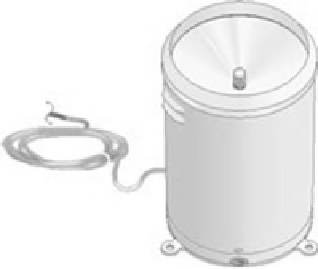Geoscience Reference
In-Depth Information
(a)
Tipping bucket
Splash guard
Splash guard
(b)
Mercoid switch
Cable to
recorder
Figure 12.4
A tipping bucket rain gauge: (a) simplified diagram of internal mechanism; (b) external view of the gauge
assembly. (From Sumner, 1988, published with permission.)
The water fills one bucket and, when this is full, the bucket assembly tips, emptying
the first bucket and simultaneously positioning the second bucket under the funnel
outlet. The second bucket then fills and when it is full the system tips in the
opposite direction. Each time a tip occurs, an electrical signal is sent to a digital
recorder that either records the time of the tip if high frequency intensity
measurements are required, or the number of tips over a predefined interval if
integrated rainfall amount is required. The precision of the measurement is limited
by the volume of the bucket. Smaller buckets give higher precision, but they can
pose problems in intense rainfall when water loss may occur because the tip rate is
high. The simplicity of the mechanism involved in the tipping bucket rain gauge
means it is a robust, reliable and much used instrument. However, in recent years
the advent of devices (strain gauges/load cells) with electronic output that are
capable of accurately measuring the weight of water stored in the chamber below
a gauge funnel has resulted in an alternative to the tipping bucket rain gauge that
has few moving parts and potentially requires less servicing because of this.
Areal representativeness of gauge measurements
Gauges provide point samples of the precipitation at a particular place. Comparison
with other data sampling challenges puts the rainfall sampling issue into






